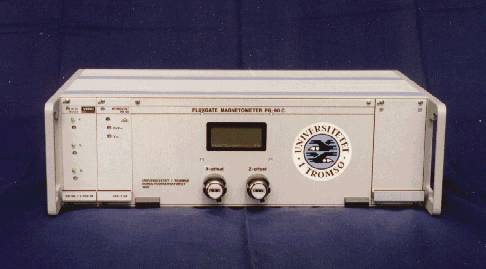|
The Auroral Observatory, University of Tromsø, has for 60 years been performing geomagnetic observations in Tromsø and at stations in the arctic. Up to 1986 the observations were mainly based on classical magnetometers with photographic recording. Since 1986, a transition to fluxgate magnetometers and digital recording has taken place. After 1991, all our stations use digital recording. The design of our first generation fluxgate instrument, FG85B, was basically a copy of the design used by the Danish Meteorological Institute, Copenhagen. The generous help and support from them, made it possible to complete the transition to digital recording by 1988. Ten units of the FG85B have been buildt. The output of the FG85B was analog, the filtering and digitizing were performed in the data logging unit. In the second generation fluxgate magnetometers, FG90B and FG90C, filters and digitizing are integrated in the same unit as the fluxgate electronics, and the output is in digital serial form. The instrument described below is our third generation fluxgate magnetometer, named FG90C. The fluxgate electronics of this new instrument, is based on the FG85B and FG90B instrument. It has, however, been improved several places to obtain better stability. Both FG85B, FG90B and FG90C are intended for use with a 3-axis fluxgate sensor (as below) compatible with the sensor in the EDA FM-100C magnetometer. The sensor unit is intended for orientation with one sensor vertical(Z), one along the horizontal component(X) (in the magnetic meridian) and one perpendicular to this(Y) (effectively measuring declination). Engineer
Bjørn Ove Husøy
|
The FS94 Sensor:
- Three fluxgate elements
- Temperature sensor Pt-100
- Plastic housing
- Aluminium base
- Fluxgate sensor interface card
- Analog to digital converter card
- Z-80 Microcomputer card
- Display/Temperature control card
- Battery backup - (1 hour)
- Cabinet w/power supply
 |
The
sensor unit,
FS94 consists of: PANDECT INSTR.LAB LFG-A13 |
The FG90C Magnetometer
 |
| The
electronic unit consists of:
|
Instruments for Absolute Measurements
 |
Carl Zeiss
Jena 010B
This is the teodolite we use for
Angular resolution is 1 arcsec.
|
Last update 31.Oct. 2011
Børre Heitmann Holmeslet